Jasmine Plant: How to Grow and Care for This Fragrant Flower
Table of Contents
The Beauty and Aroma of Jasmine: An Overview
Jasmine, with its delicate beauty and enchanting aroma, has captured the hearts of gardening enthusiasts and fragrance lovers alike. This exquisite flowering plant belongs to the olive family (Oleaceae) and is native to tropical and subtropical regions of Asia, Europe, and Africa. Known for its stunning white or yellow blossoms, jasmine has become a symbol of purity and grace in various cultures around the world.
One of the most captivating aspects of jasmine is its intoxicating fragrance. The delicate scent of jasmine has a calming effect that can uplift our spirits and create a soothing ambiance in our homes and gardens. As a result, jasmine has been widely used in perfumery, aromatherapy, and even culinary applications. The aroma of jasmine is believed to have therapeutic properties, such as reducing anxiety and improving sleep quality.

In addition to its enchanting fragrance, jasmine is cherished for its ornamental value. Whether used as a climbing vine, shrub, or ground cover, jasmine plants add a touch of elegance and charm to any landscape. The dainty, star-shaped flowers bloom profusely, creating a visually stunning display that can be enjoyed from spring through fall, depending on the variety. With its beauty and intoxicating scent, jasmine has rightly earned its place as one of the most beloved flowers in the world.
Understanding the Different Varieties of Jasmine Plants
Jasmine plants are known for their beautiful blooms and intoxicating fragrance, making them a popular choice among gardeners. However, it’s important to understand that there are different varieties of jasmine plants, each with its own unique characteristics.
One of the most common varieties of jasmine is the Jasminum officinale, also known as the common jasmine or true jasmine. This variety is famous for its highly fragrant white flowers and can grow up to 20 feet in height. It is a vigorous grower and thrives in full sun to partial shade, making it suitable for a wide range of climates.
This table outlines the characteristics of Jasmine plants:
| GENUS NAME | Jasminum |
| COMMON NAME | Jasmine |
| PLANT TYPE | Houseplant, Shrub, Vine |
| LIGHT | Part Sun, Sun |
| HEIGHT | 3 to 8 feet |
| WIDTH | 3 to 15 feet |
| FLOWER COLOR | Pink, White, Yellow |
| FOLIAGE COLOR | Blue/Green |
| SEASON FEATURES | Fall Bloom, Spring Bloom, Summer Bloom, Winter Bloom |
| SPECIAL FEATURES | Fragrance, Good for Containers, Low Maintenance |
| ZONES | 10, 6, 7, 8, 9 |
| PROPAGATION | Layering, Seed, Stem Cuttings |
| PROBLEM SOLVERS | Deer Resistant, Good For Privacy, Groundcover, Slope/Erosion Control |
Another popular variety is the Jasminum sambac, also known as Arabian jasmine or sampaguita. This variety is native to Southeast Asia and is highly revered for its sweet and exotic fragrance. It is a compact plant, reaching a height of about 3 to 6 feet, and is often used in perfumes and floral garlands. Arabian jasmine prefers full sun and well-drained soil, making it ideal for tropical and subtropical regions.
In addition to these two commonly known varieties, there are several other types of jasmine plants, each with its own distinctive features. Some varieties, like the Jasminum grandiflorum or Spanish jasmine, have larger flowers and a strong, musky scent. Others, like the Jasminum polyanthum or pink jasmine, offer delicate pink flowers and a sweeter fragrance. Whether you prefer a vine-like jasmine that climbs trellises or a compact bushy shrub, there is a jasmine variety to suit every gardener’s taste and climate.
Understanding the different varieties of jasmine plants is essential for selecting the right one for your garden. By considering factors such as fragrance, height, and sunlight requirements, you can ensure that your jasmine plants thrive and bring beauty and aroma to your outdoor space.
Selecting the Right Location for Your Jasmine Plant
When selecting the right location for your jasmine plant, it is important to consider several factors that can greatly influence its growth and overall health. One crucial aspect to keep in mind is sunlight exposure. Jasmine plants thrive in full sunlight, so it is essential to choose a spot that receives at least six to eight hours of direct sunlight each day. Insufficient sunlight can lead to stunted growth, fewer flowers, and weak stems. Additionally, it is important to avoid placing your jasmine plant in areas with excessive shade, as this can prevent proper photosynthesis and hinder its overall development.

In addition to sunlight, temperature is another significant consideration for selecting the right location for your jasmine plant. Jasmine plants prefer warm climates and temperatures ranging between 60°F and 75°F (15°C to 24°C). Frost or freezing temperatures can be detrimental to their health, so it is vital to protect them during the colder months. If you live in an area with harsh winters, consider growing your jasmine plant in a container that can be moved indoors during the colder seasons. By providing the ideal temperature conditions, you will ensure your jasmine plant thrives and produces an abundance of beautiful blooms.
Preparing the Soil for Optimal Growth and Blooming
Preparing the soil is a crucial step in ensuring optimal growth and blooming of your jasmine plants. The quality and composition of the soil directly impact the plant’s ability to absorb essential nutrients and water, as well as its overall health and vigor.
To begin, it is important to test the pH level of the soil. Jasmine plants thrive in slightly acidic to neutral soil, with a pH range of 6.0 to 7.0. If the pH level is too high or too low, it can affect nutrient availability and lead to deficiencies or toxicity. Adjusting the pH can be done by adding amendments such as sulfur to lower the pH or lime to raise it.
Next, consider the soil’s texture and drainage capabilities. Jasmine plants prefer well-draining soil that retains some moisture but does not become waterlogged. Sandy loam or loamy soil types are ideal, as they provide a balanced combination of drainage and water retention. If your soil is heavy clay or compacted, incorporating organic matter like compost or well-rotted manure can improve its structure and drainage.
In addition to amending the soil’s pH and texture, it is beneficial to enrich it with organic matter. This can be done by adding compost, leaf mold, or aged manure, which not only adds nutrients but also enhances the soil’s ability to retain moisture and promote beneficial microbial activity. Applying a layer of mulch around the base of the plant can further conserve moisture, regulate soil temperature, and suppress weed growth.
By taking the time to prepare the soil properly, you are setting the stage for your jasmine plants to flourish. With the right balance of nutrients, moisture, and drainage, your plants will be well-equipped to produce an abundance of fragrant and beautiful blooms.
Planting Your Jasmine: Step-by-Step Instructions
Planting jasmine requires careful attention to detail in order to ensure optimal growth and blooming. Here’s a step-by-step guide to help you successfully plant your jasmine:
1. Choose the right location: Select a spot that receives full sunlight for at least six hours a day. Jasmine plants thrive in warm climates, so make sure the location offers protection from strong winds and frost.
2. Prepare the soil: Jasmine prefers well-draining soil with a pH level between 6.0 and 7.5. Before planting, loosen the soil and remove any weeds or debris. Incorporating organic matter such as compost or aged manure can improve soil fertility and drainage.
3. Dig the planting hole: Dig a hole that is twice as wide and deep as the root ball of your jasmine plant. Gently tease out the roots to encourage outward growth.
4. Place the jasmine plant: Carefully place the jasmine plant in the planting hole, ensuring that the top of the root ball is level with or slightly above the soil surface. Backfill the hole with soil, pressing it firmly around the roots to eliminate air pockets.
5. Water thoroughly: After planting, water the jasmine plant deeply to settle the soil. Provide regular watering, keeping the soil moist but not saturated. Be mindful not to overwater, as jasmine plants are susceptible to root rot.
By following these step-by-step instructions, you will give your newly planted jasmine the best start for healthy growth and vibrant blossoms. Remember to continue to care for your jasmine by providing adequate sunlight, regular watering, and proper pruning. With proper attention, your jasmine plant will reward you with its exquisite beauty and delightful fragrance.
Watering and Moisture Needs of Jasmine Plants
Water is a crucial element in the growth and development of jasmine plants. Proper watering techniques can ensure the health and vigor of these fragrant beauties. The watering needs of jasmine plants vary depending on factors such as the climate, soil type, and stage of growth. Overwatering or underwatering can both lead to detrimental effects on the plant’s overall health.
To determine the appropriate watering schedule, it is essential to monitor the moisture level of the soil regularly. A general guideline is to water jasmine plants deeply but infrequently. This encourages the roots to grow deep into the soil, establishing a stronger foundation for the plant. However, it is crucial not to let the soil dry out completely between watering sessions, as jasmine plants prefer evenly moist soil. The top inch of the soil should be allowed to dry slightly before the next watering. By maintaining this balance, you can prevent root rot and ensure the plant’s optimal health.
Providing Adequate Sunlight for Healthy Growth
Adequate sunlight is crucial for the healthy growth of jasmine plants. As sun-loving plants, they thrive when exposed to full sun or at least six to eight hours of direct sunlight each day. Without sufficient sunlight, jasmine plants may become weak, leggy, and fail to produce abundant blooms.
When considering the location for your jasmine plant, choose an area that receives ample sunlight throughout the day. Ideally, this would be a south- or west-facing spot in your garden that is not shaded by tall buildings or trees. Remember that even a few hours of shade during the day can significantly impact the plant’s growth and flowering capabilities.
To ensure your jasmine plant receives adequate sunlight, regularly monitor the sun patterns in your garden. Observe how the sun moves throughout the day and identify areas that provide the most consistent and direct sunlight. By selecting a suitable location and understanding the sunlight requirements of jasmine plants, you can promote healthy growth and enjoy the beauty and fragrance these plants have to offer.
Pruning and Training Techniques for Jasmine Plants
Pruning and training techniques play a crucial role in shaping and maintaining healthy and attractive jasmine plants. Proper pruning helps to control the growth, improve air circulation, and promote flowering. When it comes to jasmine plants, it is important to remember that they have different growth habits and pruning requirements. For vining varieties like Jasminum polyanthum or Confederate jasmine, periodic pruning helps to keep the plant in check and prevent it from becoming too overgrown. This can be done by selectively removing old or damaged branches, as well as any growth that is straying from its desired location. For shrub-like varieties such as Jasminum officinale or common jasmine, pruning should focus on shaping the plant and encouraging new growth for future blooming. It is recommended to prune after flowering to avoid cutting off potential buds.

Training techniques are equally important for jasmine plants, especially for the vining varieties. As jasmine plants grow, they naturally produce long, flexible stems that can be trained to climb up trellises, fences, or other vertical supports. By gently guiding and tying the stems to these supports, gardeners can create beautiful arrangements that not only showcase the jasmine’s blooms but also maximize the use of limited space. Additionally, regular training helps to prevent the plant from becoming tangled or unruly, making it easier to maintain and enjoy. Whether you choose to train your jasmine plants horizontally, vertically, or in an artistic pattern, be sure to use soft materials such as plant ties or twine to avoid damaging the delicate stems.
Remember, pruning and training techniques should be done with care and consideration for the specific variety of jasmine you are growing. By following proper techniques, you can ensure that your jasmine plants stay healthy, well-shaped, and vibrant year after year.
Fertilizing Jasmine Plants: Dos and Don’ts
Dos and Don’ts of Fertilizing Jasmine Plants
Do you want your jasmine plants to thrive and flourish with vibrant blooms and a delightful fragrance? Proper fertilization is key to achieving healthy growth and abundant flowering. However, it’s important to keep in mind a few dos and don’ts when it comes to fertilizing your precious jasmine plants.
DO choose the right fertilizer for your jasmine plants. Opt for a balanced, slow-release fertilizer with equal amounts of nitrogen, phosphorus, and potassium. This will provide the essential nutrients needed for healthy plant development. Additionally, look for a fertilizer that includes micronutrients such as iron, manganese, and zinc, which are crucial for proper plant nutrition.
DON’T overfertilize your jasmine plants. While it may be tempting to think that more fertilizer will yield better results, overfertilization can actually harm your plants. Excessive nutrients can build up in the soil, leading to root burn and stunted growth. It’s essential to follow the recommended dosage provided by the fertilizer manufacturer and err on the side of caution when feeding your plants.
Remember, proper fertilization is just one piece of the puzzle when it comes to caring for your beloved jasmine plants. Stay tuned for more tips and techniques to help you create a thriving garden filled with the beauty and aroma of jasmine.
– DO choose a balanced, slow-release fertilizer with equal amounts of nitrogen, phosphorus, and potassium
– DO look for a fertilizer that includes micronutrients such as iron, manganese, and zinc
– DON’T overfertilize your jasmine plants
– DON’T exceed the recommended dosage provided by the fertilizer manufacturer
– Proper fertilization is essential for healthy plant development and abundant flowering in jasmine plants.
Dealing with Common Pests and Diseases
Jasmine plants, like any other plant, can be susceptible to a variety of pests and diseases. It is essential for gardeners to be aware of these common issues and take appropriate measures to prevent and control them. One common pest that affects jasmine plants is aphids. These small insects feed on the plant’s sap, causing leaves to wilt and become discolored. To combat aphids, you can try using insecticidal soap or introducing beneficial insects like ladybugs to your garden. Another pest that jasmine plants may encounter is the whitefly. These tiny flies typically congregate on the undersides of leaves, sucking out plant fluids and leaving behind a sticky residue known as honeydew. Neem oil spray or yellow sticky traps can be effective in controlling whiteflies. Additionally, scale insects may attack jasmine plants by attaching themselves to leaves and stems and feeding on plant fluids. Pruning heavily infested branches and applying horticultural oil can help manage these pests.
When it comes to diseases, powdery mildew is a common problem that jasmine plants can face. This fungal infection appears as white or gray powdery patches on the leaves and can inhibit the plant’s growth and flowering. To prevent powdery mildew, make sure your jasmine plants have adequate air circulation and are not overcrowded. If powdery mildew does appear, you can treat it with a fungicide specifically formulated for this disease. Another disease that affects jasmine plants is root rot, which is caused by overwatering or poor drainage. To avoid root rot, ensure that your plants are not sitting in waterlogged soil and that the soil is well-draining. If you notice signs of root rot, such as yellowing leaves or a foul odor, adjust your watering regimen accordingly and consider repotting the plant in fresh, well-draining soil.
By being proactive and implementing preventive measures, such as proper plant care, regular inspection, and prompt action when necessary, you can minimize the impact of pests and diseases on your jasmine plants. Remember to stay vigilant, as early detection and treatment are key to maintaining the health and beauty of your jasmine garden.
Propagating Jasmine Plants: Methods and Tips
Propagating jasmine plants is a rewarding process that allows you to expand your collection and share the beauty of this aromatic plant with others. There are several methods you can use to propagate jasmine, each with its own advantages. One common method is through stem cuttings. Select a healthy stem that is about 4-6 inches long and remove any leaves from the bottom half of the stem. Dip the cut end in rooting hormone to encourage root development, then plant the cutting in a well-draining potting mix. Keep the soil consistently moist, and within a few weeks, you should start to see roots forming.
This table outlines various methods and tips for propagating jasmine plants:
| Propagation Method | Description |
|---|---|
| Stem Cuttings | Select healthy stems with no flowers, cut at a 45-degree angle, remove lower leaves, dip in rooting hormone, and plant in well-draining soil. |
| Layering | Encourage rooting by bending a low branch to the ground, making a small incision, applying rooting hormone, and covering with soil until roots develop. |
| Air Layering | Create a ring of bark on a stem, wrap with moist sphagnum moss and plastic, secure with twine, and wait for roots to form before cutting and planting. |
| Seed Propagation | Collect seeds from ripe fruits, plant in a seed-starting mix, keep consistently moist, and provide warmth until germination occurs. |
Another method of propagation is layering, which is particularly useful for larger, more mature jasmine plants. To do this, select a low-growing, flexible branch and make a small cut on the underside of the branch, just below a leaf node. Apply some rooting hormone to the wounded area, then bury that section of the branch in a pot filled with soil. Keep the soil moist, and after a few months, roots should develop. Once the new plant has established roots, you can separate it from the main plant and repot it.
Overwintering Jasmine Plants: Precautions and Care
Overwintering jasmine plants requires careful attention and specific precautions to ensure their survival through the colder months. While jasmine plants are generally hardy, they can still be susceptible to frost and cold damage. To protect your jasmine during winter, it is crucial to take a few steps in advance.
First and foremost, it is important to choose the right time to prepare your jasmine for winter. This typically involves taking action before the temperatures drop consistently below freezing. It is advisable to start the preparation process in late autumn, allowing the plant to gradually adjust to the changing conditions. This will help the jasmine to enter a state of dormancy, which is necessary for its survival. During this time, it is crucial to reduce watering and fertilization to allow the plant to enter a dormant state naturally.
To further safeguard your jasmine during the winter, providing adequate insulation is essential. This can be achieved by mulching the soil around the base of the plant with a layer of organic materials, such as straw or wood chips. The mulch acts as an insulating barrier, protecting the roots from extreme temperature fluctuations and reducing the risk of frost damage. Additionally, wrapping the plant in burlap or a similar protective material can provide an extra layer of insulation against the cold. It is important to secure the wrapping tightly to prevent wind damage and ensure that the plant remains well-protected throughout the winter season.
By following these precautions and providing the necessary care, your jasmine plants have a higher chance of surviving the winter months and thriving when the warmer weather returns. Stay tuned for the next section on enhancing fragrance: companion plants for jasmine, which will explore how other plant species can complement and enhance the beautiful aroma of jasmine in your garden.
Enhancing Fragrance: Companion Plants for Jasmine
Jasmine plants not only delight the eyes with their beautiful blooms, but they also captivate our senses with their enchanting fragrance. To enhance the aromatic experience in your garden, consider planting companion plants that complement the scent of jasmine. These plants can create a harmonious blend of fragrances and add an extra layer of allure to your outdoor space.
One excellent companion plant for jasmine is lavender (Lavandula). Its soothing and calming scent pairs wonderfully with the sweet aroma of jasmine. Lavender’s delicate purple flowers also provide a visually stunning backdrop to the vibrant white or yellow blossoms of jasmine. Planting lavender near your jasmine can create a sensory oasis, where the combination of their fragrances transports you to a serene and tranquil environment. Additionally, both jasmine and lavender are loved by pollinators, attracting bees and butterflies to your garden, further enriching the ecosystem.
Watch this video to know more about jasmine plants!
Another aromatic companion for jasmine is rosemary (Rosmarinus officinalis). With its distinctive fragrance reminiscent of pine and lemon, rosemary adds a refreshing and invigorating element to the floral bouquet of jasmine. This versatile herb also has culinary uses, making it a practical addition to your garden. The upright growth habit of rosemary can provide an elegant and structured backdrop to the cascading vines of jasmine, creating a visually appealing and fragrant tapestry in your garden.
Troubleshooting: Common Issues and Solutions for Jasmine Plants
Jasmine plants are generally low-maintenance and resilient. However, like any other plant, they may encounter some problems that can affect their growth and overall health. By understanding common issues and their solutions, you can ensure that your jasmine plants thrive in your garden or indoor space.
One common issue with jasmine plants is yellowing leaves. This can be caused by a variety of factors, including nutrient deficiencies, overwatering, or inadequate sunlight. To address this issue, it is important to first identify the cause. Test the soil pH to ensure it is within the appropriate range for jasmine plants. If necessary, adjust the soil’s pH by adding organic matter or suitable fertilizers. Additionally, make sure your jasmine plants receive enough sunlight, as they require at least 6 hours of direct sunlight per day. Finally, water your plants sparingly and only when the top few inches of soil feel dry. Avoid overwatering, as this can lead to root rot and yellowing leaves. By addressing these factors, you can help your jasmine plants regain their vibrancy and health.
Another common issue is the manifestation of pests, such as aphids or spider mites, which can attack jasmine plants. These pests suck sap from the leaves, resulting in stunted growth and distorted foliage. To combat this problem, it is essential to regularly inspect your plants for any signs of infestation. If you spot aphids or spider mites, try using a homemade insecticidal soap or a commercially available organic insecticide. Apply the solution according to the instructions on the package, making sure to thoroughly cover both sides of the leaves. It may also be helpful to gently wipe the leaves with a damp cloth to remove any existing pests. By promptly treating pest infestations, you can prevent further damage to your jasmine plants and maintain their overall health and vitality.
Why are the leaves of my jasmine plant turning yellow?
Yellowing leaves on a jasmine plant can be a sign of overwatering or nutrient deficiencies. Make sure you are not overwatering your plant and check the soil moisture before watering. Additionally, provide the plant with a balanced fertilizer to address any nutritional deficiencies.
How often should I prune my jasmine plant?
Pruning requirements vary depending on the jasmine variety, but generally, it is recommended to prune jasmine plants immediately after flowering. This helps promote new growth and maintain a compact shape. Regular light pruning throughout the year to remove dead or damaged branches is also beneficial.
Can I grow jasmine indoors?
Yes, certain jasmine varieties can be grown indoors. Choose a compact variety and place it in a location that receives bright, indirect sunlight. Ensure proper ventilation and maintain a consistent temperature between 60-75°F (15-24°C). Indoor jasmine plants may require additional humidity, so misting the leaves or using a humidifier can be helpful.
How can I control pest infestations on my jasmine plant?
Common pests that affect jasmine plants include aphids, spider mites, and whiteflies. To control these pests, you can try using insecticidal soaps or horticultural oils. Regularly inspect your plant for signs of infestation and take immediate action to prevent the spread of pests.
Can I propagate jasmine plants from cuttings?
Yes, jasmine plants can be easily propagated from cuttings. Take a 4-6 inch (10-15 cm) long cutting from a healthy stem, remove the lower leaves, and dip the cut end in a rooting hormone. Plant the cutting in a well-draining potting mix and keep it in a warm and humid environment until roots develop.
How do I overwinter my jasmine plant?
In colder regions, jasmine plants need protection during winter. Before the first frost, bring potted jasmine plants indoors and place them in a cool room with temperatures around 50°F (10°C). Water sparingly during this period and reduce fertilization. In-ground jasmine plants should be covered with a layer of mulch to insulate the roots.
Can I plant other flowers alongside jasmine to enhance its fragrance?
Yes, there are several companion plants that can enhance the fragrance of jasmine. Consider planting sweet peas, honeysuckle, or lavender near your jasmine plant. These flowers not only complement the fragrance of jasmine but also attract beneficial pollinators.

Pallavi Gupta is a burgeoning writer at SouthElMonteHydroponics, blending her passion for data analysis with a keen interest in biotechnology. Currently pursuing a Bachelor’s in Biotechnology at Amity University, Pallavi delves into the intricacies of life sciences while gaining hands-on experience in the exciting world of data analysis. Her unique background provides a fresh perspective on hydroponic farming, as she explores the intersection of biotechnology and sustainable agriculture. Through her writing, Pallavi aims to bridge the gap between data-driven insights and innovative farming practices, inspiring others to harness technology for a greener future.







